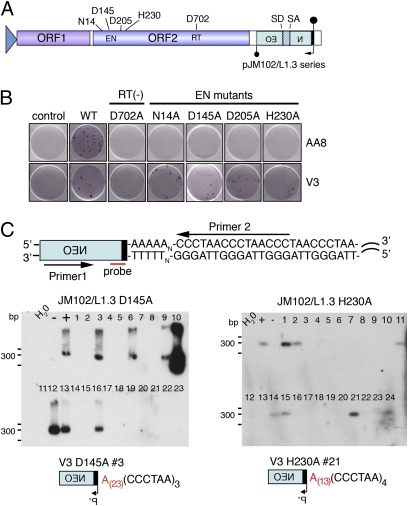Fig. 1.
L1-EN mutants can retrotranspose to dysfunctional telomeres. (A) An RC-L1 is shown with conserved residues in the EN (N14, D145, D205, and H230) and RT (D702) domains. The blue triangle represents a CMV promoter in the pJM102/L1.3 constructs. A neomycin phosphotransferase reporter cassette interrupts the 3′ UTR. The cassette contains its own promoter (upside-down arrow) and is interrupted by an intron with splice donor (SD) and splice acceptor (SA) sites. “Lollipops” mark polyadenylation signals for both transcriptional orientations. (B) L1 constructs with mutations in the EN or RT domain are unable to retrotranspose in AA8 CHO cells (Upper) but can retrotranspose in V3 CHO cells (Lower). Mock transfected cells = control. (C) Schematic of the PCR/Southern blot assay. Relative positions of the primer specific to the retrotransposed L1 (Primer 1), a telomere primer (Primer 2), and the probe are shown. Panels of the PCR/Southern blot assay show that some clonal V3 cell lines harbor an ENi retrotransposition event at a telomere (pJM102/L1.3 wild type and pJM102/L1.3 N14A are shown in Fig. S2). A schematic of a representative PCR product positive for retrotransposition at telomeres from a clonal cell line is shown.

